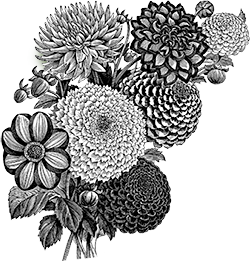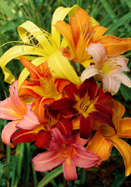Here you’ll find our VERY rarest bulbs along with late finds and others we simply couldn’t squeeze into our print catalog.
Those marked “Web-Only & Rarest” are sometimes in such short supply that they sell out within days — and some years we can’t offer them at all — so if you see one you like, we recommend you order it now!
|
|
|
|
|
|
|
With cottage-garden grace and surprising diversity, antique daylilies are waiting to be rediscovered by modern gardeners. Sample their old-fashioned charms with 3 of our favorites, all different, labeled, and great for your area. (Several possibilities are pictured.) For zones 4a-8b(9aWC).
For more of each variety, order additional samplers. Daylily care. Spring shipped, click here for summer shipped.
|
|
|
|
Tall, tall, TALL – with bloom stalks up to 7 feet! – this remarkable daylily may get you and your garden visitors babbling. Up close its spidery, gold and chestnut flowers are nothing special, but when you see them held high against the sky on their strong, slender stalks – often with hummingbirds flitting about – they’re magic. By A.B. Stout, from the wild H. altissima, 5-7’, late blooming, lightly fragrant, deciduous, 2-3 fans, zones 4a-8b(10aWC), from our own micro-farm. Chart, care, and learn more. Spring shipped, click here for summer shipped.
|
|
|
|
With charming, not-so-big flowers of a lemon yellow that’s both soft and bright, this rarely offered Depression-era beauty mingles easily with other perennials and adds a cooling note to the mid-summer garden. It was bred by the master A.B. Stout himself who liked it so well that he named it for Odysseus’s enchantress, the “loveliest of all immortals.” Long-blooming, 32-36”, mid-summer blooming, deciduous, 2-3 fans, zones 4a-8b(9bWC), from our own micro-farm. Chart and care. Summer shipped, click here for spring shipped.
|
|
|
|
With charming, not-so-big flowers of a lemon yellow that’s both soft and bright, this rarely offered Depression-era beauty mingles easily with other perennials and adds a cooling note to the mid-summer garden. It was bred by the master A.B. Stout himself who liked it so well that he named it for Odysseus’s enchantress, the “loveliest of all immortals.” Long-blooming, 32-36”, mid-summer blooming, deciduous, 2-3 fans, zones 4a-8b(9bWC), from our own micro-farm. Chart and care. Spring shipped, click here for summer shipped.
|
|
|
|
This striking daylily was one of Stout’s first and favorite introductions. Over the years its bold mango-and-mahogany coloring and graceful star-like form have won it many fans, including the great Elizabeth Lawrence who praised it as one of her “15 Best.” Vigorously multiplying and floriferous, it often reblooms in the fall in warm areas. 30-36”, early-mid season, semi-evergreen, 2 fans, zones 4a-8b(10aWC), from our own micro-farm. Chart and care. Spring shipped, click here for summer shipped.
|
|
|
|
We’re thrilled to finally offer this dramatic beauty, after years of building up stock. It’s a deep raspberry-rose highlighted by an orange throat and ivory midrib lines that really make it pop. And its name? Artists may recognize it as the name of the color of the celebrated old rose ‘Paul Neyron’ of 1869. RHS AGM, 30-32”, mid, 2 fans, zones 4a-8a(10aWC), from our own micro-farm. Chart and care. Spring shipped, click here for summer shipped.
|
|
|
|
We’re thrilled to finally offer this dramatic beauty, after years of building up stock. It’s a deep raspberry-rose highlighted by an orange throat and ivory midrib lines that really make it pop. And its name? Artists may recognize it as the name of the color of the celebrated old rose ‘Paul Neyron’ of 1869. RHS AGM, 30-32”, mid, 2 fans, zones 4a-8a(10aWC), from our own micro-farm. Chart and care. Summer shipped, click here for spring shipped.
|
|
|
|
We can’t understand why everyone isn’t growing this great little daylily. It blooms remarkably early – with the first bearded iris of May – and profusely, even in the half-shade of our old grape arbor. Its graceful, star-like flowers are a cheery yellow-orange that’s somewhere between mangoes and California poppies. And it’s one of the oldest survivors from the very dawn of daylily breeding, by school teacher George Yeld. 24-30”, deciduous, zones 4a-8b(9bWC), from our own micro-farm. Chart and care. Summer shipped, click here for spring shipped.
|
|
|
|
We can’t understand why everyone isn’t growing this great little daylily. It blooms remarkably early – with the first bearded iris of May – and profusely, even in the half-shade of our old grape arbor. Its graceful, star-like flowers are a cheery yellow-orange that’s somewhere between mangoes and California poppies. And it’s one of the oldest survivors from the very dawn of daylily breeding, by school teacher George Yeld. 24-30”, deciduous, zones 4a-8b(9bWC), from Michigan. Chart and care. Spring shipped, click here for summer shipped.
|
|
|
|
One of the latest, longest-blooming, and brightest daylilies we grow, ‘Princess Irene’ will draw you from across the garden with its joyful brilliance, from mid-summer well into fall. With its star-like form and almost wriggling petals, it’s the only daylily ever introduced by H. A. Zager of Des Moines – but he sure picked a winner. 28-34”, late-mid to late, deciduous, 2 fans, zones 4a-8a(10aWC), from our Ann Arbor micro-farm. Chart and care. Summer shipped, click here for spring shipped.
|
|
|
|
One of the latest, longest-blooming, and brightest daylilies we grow, ‘Princess Irene’ will draw you from across the garden with its joyful brilliance, from mid-summer well into fall. With its star-like form and almost wriggling petals, it’s the only daylily ever introduced by H. A. Zager of Des Moines – but he sure picked a winner. 28-34”, late-mid to late, deciduous, 2 fans, zones 4a-8a(10aWC), from our own micro-farm. Chart and care. Spring shipped, click here for summer shipped.
|
|























